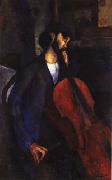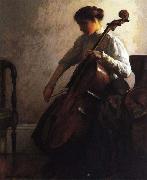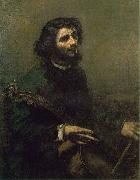Wholesale Oil Painting No Minimum |
|||||||||||
|
|
|||||||||||

|
|||||||||||
|
|
|
||||||||
Amedeo ModiglianiItalian Expressionist Painter and Sculptor, 1884-1920 Amedeo Clemente Modigliani (July 12, 1884 ?C January 24, 1920) was an Italian artist of Jewish heritage, practicing both painting and sculpture, who pursued his career for the most part in France. Modigliani was born in Livorno (historically referred to in English as Leghorn), in northwestern Italy and began his artistic studies in Italy before moving to Paris in 1906. Influenced by the artists in his circle of friends and associates, by a range of genres and art movements, and by primitive art, Modigliani's œuvre was nonetheless unique and idiosyncratic. He died in Paris of tubercular meningitis, exacerbated by poverty, overworking, and an excessive use of alcohol and narcotics, at the age of 35. |
||||||||
|
|
||||||||
The Cellist
The Cellist Painting ID:: 10528 |
1909, oil on canvas, 51 1/4 x 31 7/8 ins(130x81cm). Private Collection. 1909, oil on canvas, 51 1/4 x 31 7/8 ins(130x81cm). Private Collection. |
|||||||
|
|
||||||||
Joseph Decamp1858-1923 Joseph Rodefer DeCamp (November 5, 1858 - February 11, 1923) was an American painter. Born in Cincinnati, Ohio, he studied with Frank Duveneck in that city. In the second half of the 1870s he went with Duveneck and fellow students to the Royal Academy of Munich, then spent time in Florence, Italy, returning to Boston in 1883. He became known as a member of the Boston school led by Edmund Charles Tarbell and Emil Otto Grundmann, focusing on figure painting, and in the 1890s adopting the style of Tonalism. He was a founder of the Ten American Painters, a group of American Impressionists, in 1897. A 1904 fire in his Boston studio destroyed several hundred of his early paintings, including nearly all of his landscapes. He died in Boca Grande, Florida. |
||||||||
|
|
||||||||
|
|
The Cellist
The Cellist Painting ID:: 58594 |
The Cellist, 1908
The Cellist, 1908 |
||||||
|
|
||||||||
Joseph Decamp1858-1923 Joseph Rodefer DeCamp (November 5, 1858 - February 11, 1923) was an American painter. Born in Cincinnati, Ohio, he studied with Frank Duveneck in that city. In the second half of the 1870s he went with Duveneck and fellow students to the Royal Academy of Munich, then spent time in Florence, Italy, returning to Boston in 1883. He became known as a member of the Boston school led by Edmund Charles Tarbell and Emil Otto Grundmann, focusing on figure painting, and in the 1890s adopting the style of Tonalism. He was a founder of the Ten American Painters, a group of American Impressionists, in 1897. A 1904 fire in his Boston studio destroyed several hundred of his early paintings, including nearly all of his landscapes. He died in Boca Grande, Florida. |
||||||||
|
|
||||||||
|
|
The Cellist
The Cellist Painting ID:: 72090 |
1908(1908)
Oil on canvas
71.12 X 58.57 cm (28 X 23.06 in)
1908(1908) Oil on canvas 71.12 X 58.57 cm (28 X 23.06 in) |
||||||
|
|
||||||||
Gustave Courbet1819-1877 French Gustave Courbet Locations was a French painter whose powerful pictures of peasants and scenes of everyday life established him as the leading figure of the realist movement of the mid-19th century. Gustave Courbet was born at Ornans on June 10, 1819. He appears to have inherited his vigorous temperament from his father, a landowner and prominent personality in the Franche-Comte region. At the age of 18 Gustave went to the College Royal at Besancon. There he openly expressed his dissatisfaction with the traditional classical subjects he was obliged to study, going so far as to lead a revolt among the students. In 1838 he was enrolled as an externe and could simultaneously attend the classes of Charles Flajoulot, director of the ecole des Beaux-Arts. At the college in Besançon, Courbet became fast friends with Max Buchon, whose Essais Poetiques (1839) he illustrated with four lithographs. In 1840 Courbet went to Paris to study law, but he decided to become a painter and spent much time copying in the Louvre. In 1844 his Self-Portrait with Black Dog was exhibited at the Salon. The following year he submitted five pictures; only one, Le Guitarrero, was accepted. After a complete rejection in 1847, the Liberal Jury of 1848 accepted all 10 of his entries, and the critic Champfleury, who was to become Courbet first staunch apologist, highly praised the Walpurgis Night. |
||||||||
|
|
||||||||
|
|
The Cellist
The Cellist Painting ID:: 89849 |
Oil on canvas, 117 x 90 cm, Nationalmuseum, Stockholm
Date 1847(1847)
cyf Oil on canvas, 117 x 90 cm, Nationalmuseum, Stockholm Date 1847(1847) cyf |
||||||
|
|
||||||||
|
Gustave Courbet 1819-1877 French Gustave Courbet Locations was a French painter whose powerful pictures of peasants and scenes of everyday life established him as the leading figure of the realist movement of the mid-19th century. Gustave Courbet was born at Ornans on June 10, 1819. He appears to have inherited his vigorous temperament from his father, a landowner and prominent personality in the Franche-Comte region. At the age of 18 Gustave went to the College Royal at Besancon. There he openly expressed his dissatisfaction with the traditional classical subjects he was obliged to study, going so far as to lead a revolt among the students. In 1838 he was enrolled as an externe and could simultaneously attend the classes of Charles Flajoulot, director of the ecole des Beaux-Arts. At the college in Besançon, Courbet became fast friends with Max Buchon, whose Essais Poetiques (1839) he illustrated with four lithographs. In 1840 Courbet went to Paris to study law, but he decided to become a painter and spent much time copying in the Louvre. In 1844 his Self-Portrait with Black Dog was exhibited at the Salon. The following year he submitted five pictures; only one, Le Guitarrero, was accepted. After a complete rejection in 1847, the Liberal Jury of 1848 accepted all 10 of his entries, and the critic Champfleury, who was to become Courbet first staunch apologist, highly praised the Walpurgis Night. The Cellist Oil on canvas, 117 x 90 cm, Nationalmuseum, Stockholm Date 1847(1847) cyf |
||||||||
|
|
||||||||
|
Prev Next
|
||||||||
|
|
||||||||
|
Related Paintings to Gustave Courbet :. |
||||||||
|
|
||||||||
|
CONTACT US |




